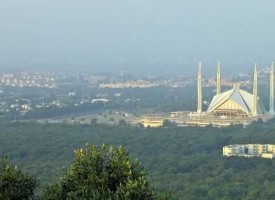Pakistan is home to four provinces (Punjab, Balochistan, Sindh and KP) and three autonomous zones (FATA, Gilgit-Baltistan (GB) and Azad Kashmir). Living in these areas are people belonging to hundreds of tribes/clans and thousands of sub-communities. Most, if not all, have their distinct socio-cultural identity which accords them special historical importance.
From the mountains of Chitral to the deserts of Balochistan, from the plains of Punjab to the coastline in Karachi; all these communities, though individually different, collectively form part of Pakistan’s cultural heritage. A culture that is all-inclusive and fosters support and encouragement among its followers to preserve and promote their culture through folklore, folk music, attire, lifestyle, customs, traditions, rites and rituals. Sindhis have their rich cultural heritage such as the ajrak cap, the Sufi poetry, folklore from interior Sindh; Balochis have tribal stories of their sardars, a desert-oriented Arabist culture with a nomadic way of life and bright, colorful dresses; Punjabis have a rich cultural heritage with all sorts of customs, clothes and traditions whereas the Pashtuns of KP have their culture which to some extent resembles that of their colleagues in Afghanistan. Millions of historical books, artifacts and other works of art/literature were created by the intelligentsia of each cultural community.
Communities in Pakistan have heterogeneous cultures, this is where the beauty of diversity can be witnessed firsthand. What matters is the fact that they get recognition and acknowledgement from the State of Pakistan. Historically-speaking, the one factor which united all these nations and tribes to gather together for independence was Islam. Nothing but the love for Islam and its politico-socio-economic system moved many a Muslim hearts to leave everything in mainland India and migrate to their newly-created homeland. To be noted that nowhere did the founders of Pakistan try to fuse together all cultures into an amalgamated whole.
Before the advent of private television, the Pakistan Television Network (PTV) kept holding the fabric of Pakistan’s cultural heritage together. Since many private business conglomerates and industrialists were establishing channels for their own vested (“commercial”) interests, their focus was on minting as much money as they could. This is also the period when private cable operators emerged in the scene.
Soaps, drama serials, telefilms and music videos which appeared Pakistani on the outset started mutating into a hybrid mix of Pakistani culture with the onslaught of American, British, Turkish, Arabic and Indian culture. Not just in the media, these developments eventually spread throughout the Pakistani society. Hence the reason why after frequent intervals, we are left asking ourselves, ‘What is Pakistani culture?’
We have forgotten our colorful but simplistic ways of life, sitting with elders to listen to what they have to pass down to us, their coming generations. Spending quality time with elders, for example, is a very common trend among the communities in Pakistan. It forms part of our national culture. Attending poetry recitals, ghazal/qawwali sessions and watching family-oriented drama serials, reading literary magazines and novels etc are activities which have reached the brink of extinction; we could learn many good and useful lessons from these pastime engagements.
Today, private media and the Internet have impacted Pakistani minds as adversely as it has everywhere else. The case of Pakistan begs special attention because it created a precarious dichotomy: majority of Pakistanis are xenophobic by attitude and yet, ironically, they can’t help adopting the same foreign culture whose origins they ridicule day and night. It is as if they face an identity crisis; true, the national culture of Pakistan as a combined whole has been forgotten or perhaps intentionally neglected by people who have access to the latest technology.
Cultures don’t get old. They are passed on from generation to generation. They can evolve with time as per its followers’ ambitions but to label cultures as ‘outdated’ or ‘incompatible’ with the modern age is unjustified. Modernity does not mean discarding one’s culture or identity. Modernity is the use of latest available resources to promote your culture. It is the means or a phenomenon, not the resource itself.
There is also the issue of radicalization in the society. Hardliners claim that Islam reigns supreme. Undoubtedly, Allah is Great and the Ruler of the Universe, but He himself mentions in The Qur’an that mankind was created “into nations and tribes, that you may know one another” (Ref: Surah Al-Hujurat, Verse 13).
Islam has a politico-socio-economic and legal model for the Muslim Ummah but nowhere does it impinge upon the cultures of a community. Diversity breeds creativity and these add joys to life. The various cultures we see in Pakistan bear testament to this fact.
Then there is the case of people who take foreign culture with too much enthusiasm; these include most of the privileged, elite lot for whom the West and India are sacred sites. Nationalist elements, by principle, should not be fearful of a foreign cultural invasion in Pakistan. The reason they panic in such circumstances is because their own cultural heritage is at the verge of annihilation. When there are no internal insecurities, how can a foreign threat terrorize us?
Pakistanis are themselves responsible for neglecting cultures of their respective communities they belong to: Punjabi, Balochi, Sindhi, Pathan, Urdu-speaking, Kashmiri, Balti, Cholistani, Seraiki, Hazara, whatever it be, it is our responsibility to preserve our cultural heritage and pass it on to our next generation. When adequate measures have been put in place to ensure that our heritage is dominant, no cultural import will threaten our history. It is diverse, centuries old, rich and inspirational.
Protecting Pakistan’s cultural heritage should form the basis of our efforts to protect our national identity. Only we can uphold our forefathers’ cultural traits and if we persist in non-seriousness, we alone will be responsible for their demise.
image credit: bigstockphoto.com








No comments!
There are no comments yet, but you can be first to comment this article.